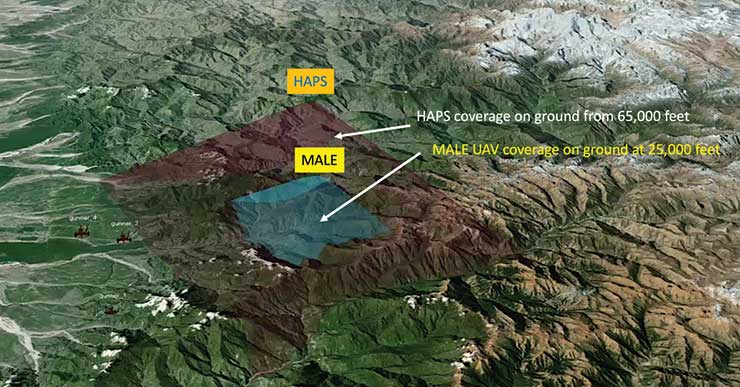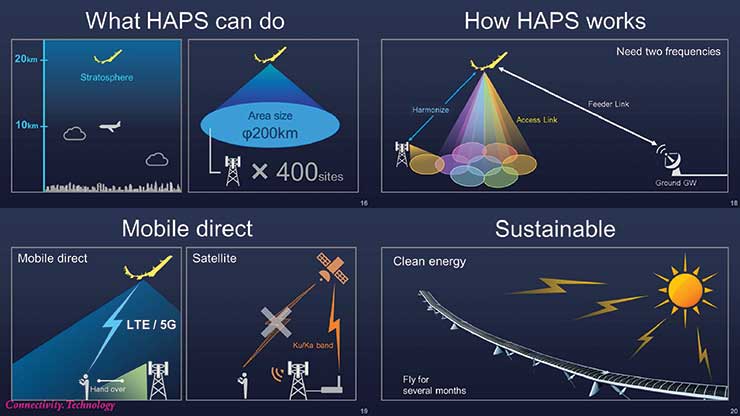Hindustan Aeronautics Limited (HAL) has teamed up with a next generation missions and technologies (NGM&T) start-up NewSpace Research & Technologies Pvt Ltd (NRT) to begin work on a massive solar powered unmanned aircraft designed to stay aloft in the stratosphere for months. The 50m plus span High Altitude Pseudo Satellite (HAPS) UAV is part of a new genre of solar powered platforms being designed across the world for persistent surveillance, communications and specialist science missions. Dubbed as ‘CATS-Infinity’, this air vehicle will be developed under a joint development partnership model between the two companies and will be India’s maiden foray to target the largely unexploited stratosphere for military and civilian applications.
The HAL Board has cleared this ambitious program with the Indian Air Force and the Indian Navy as its targeted customers. This augurs a new era for captive indigenous aerospace R&D happening in the private ecosystem in India, where the norm has been to develop products through transfer of technology (ToT) & licensing. Here NewSpace Research & Technologies, a deep tech aerospace & defence start-up company based out of Bengaluru with its core aerospace engineering design strengths wants to make a difference. This is also a first for HAL, where it has engaged with a start-up company for a joint design & development project.
Ironically the HAPS in India has been unlocked as a R&D program through the Ministry of Defence’s Innovation for Defence Excellence (iDEX) initiative, where NewSpace Research & Technologies Pvt Ltd has signed a contract with the MOD for an initial proof of concept demonstrator which targets a solar powered flight for greater than 48 hours. Beyond this, HAL as per understanding with the MOD and the Indian Air Force, as well as a business collaborative agreement with NewSpace, will develop HAPS prototypes for the Indian Air Force & the Indian Navy each. As per news reports, the Indian govt will be investing an estimated INR 700 crores to take these prototypes to a IOC status. With HAL as the lead, NewSpace Research & Technologies will be a prime R&D and commercial partner in this effort. NewSpace has completed the initial feasibility design of the HAPS and has been supported by Boeing Phantom Works on validating the same. NewSpace Research is one of the first private sector aerospace companies in India, which has extensively used advanced design philosophies like multi-disciplinary optimisation (MDO) to design the HAPS air vehicle.

So what exactly is a High Altitude Pseudo Satellite? The HAPS is a new genre of unmanned air vehicles designed to stay aloft in the very thin air of the stratosphere. Operating at 65,000 feet, high above the air traffic and weather activity for months altogether, the HAPS can be utilised for persistent loiter needs towards military & civilian applications.
These are mostly powered by solar power, where solar energy is utilised to run the vehicle systems and charge the onboard batteries during the day, and run on the batteries at night. The cycle is repeated continuously. The number of charge and discharge cycle limit of the batteries determines the endurance of the air vehicle. The existing commercially available high density light weight lithium based battery chemistries provide an endurance of upto 90 days. Using customised electric propulsion optimised for low density air operations, the CATS-Infinity is being designed as a system to operate for over a year in the stratosphere. Advances in battery tech in the coming years will easily be incorporated to give such an endurance beyond the targeted 3 months.
However batteries along with the airframe, have the maximum mass amongst the various sub systems on the platform, which reduces the mass fraction of the useful operational payload carried down to tens of kilograms.

This is further governed by the location on the planet where the HAPS will fly, with duration of the day and the angle of sunrays falling on the solar panels making a huge difference in the sizing of the HAPS.
The wing span of the HAPS will be the lowest if designed to operate near the equator because of the near vertical sunrays falling on the panels for a longer duration, providing optimal energy balance for aircraft flight functions and charging the batteries. With increase of latitude, the duration of the day and angle of incidence of the sunrays will reduce, decreasing the optimal energy balance needed for the solar power train to fly all seasons.
This will entail increase in the solar panel area, thus increasing the wingspan and driving up design complexity and cost of the vehicle. Some amount of wind at stratospheric altitudes in certain regions will also demand more energy from the powertrain, drawing more power from the batteries, hence a need to carry more of same.
The worst case scenario for any HAPS class of vehicle is the ability to fly on the winter solstice in the northern latitudes, thus increasing the wing span to its structural limits for a 365 day operations. This is the design challenge which aerospace engineers need to address by intermatching a highly flexible and ultra-lightweight airframe, with maximum allowance for solar panels, batteries, payloads and other sub-systems. With availability of double/ triple junction GA/GaN solar cells and ultra-lightweight high density batteries > 500WH/Kg, as well as low SWAP operational payloads; the HAPS is well on its way to be a cost effective augmentation/ replacement for satellites in having the focus of an aircraft, and endurance of a satellite. The HAPS can undertake 70-80% of satellite’s persistent surveillance and communication tasks at one fourth the cost and up to three times the life cycle viability. In addition, the payloads can be dynamically swapped as per requirement unlike a satellite where the payload is lost forever.

Flying at 65,000 feet, the HAPS gets a commanding view of the landmass. In theory, one could see as far as 500 km away. At these altitude, it would also be able to reasonably listen out to 800-1000 km. Designed to fly at low speeds, these platforms will be able to persist over a point of interest endlessly, making them ideal satellite augmentation/ replacement solutions. A HAPS air vehicle operating at 65,000 feet with an endurance of 24 hours, will need to fly only 250 sorties compared to MALE UAVs operating at 25,000 feet with an endurance of 25 hours, which need to fly over 5000 sorties to have the same impact over the region of interest. This results in fewer missions and air vehicles, as well as simplified and cheaper cost of operations. The operational cost per hour of a HAPS class of vehicle is less than $500 per hour as compared to an approx. $3500 per hour for a Reaper class drone of the USAF.
The surveillance payloads for HAPS include electro optical/ infra-red (EO/IR) solutions, synthetic aperture radars (SAR) with GMTI function; communication payloads including range extenders, 4/5G/WiFi networks and backhaul data carriage, electronic intelligence (ELINT) and electronic warfare (EW). The existing technology limits of the ISR payloads for HAPS allows observations of up to 80-100 km from stratospheric altitudes, which is 2-3 more as offered by MALE UAVs. For the Indian Armed forces the HAPS will offer a hitherto unknown capability for ISR, the lack of which has been critically exposed during the Doklam crisis, the Balakot incident and the ongoing crisis in Ladakh. The Indian Navy with its vast boundary to manage across the Indian Ocean Region (IOR) will be an immediate beneficiary. Embedded with the Indian MALE UAVs and recce satellites, the HAPS will help close the huge gap in demand and supply of ISR data.

While HAPS offers endless possibilities towards military applications, its civilian applications will be even more beneficial for India in the decades to come. Here advanced use cases for a persistent eye in the sky include smart city management, natural disasters, management of logistics nodes and highways etc. Imagine how a swarm of HAPS operating on the disaster prone belts in India persistently can offer real time pre warning of a natural disaster unfolding, helping a much faster response. This will save countless lives and loss of property.
One of the most disruptive use case for the HAPS in the days ahead will be beaming down communication networks from the sky. The HAPS can provide telecommunication connectivity all over India, especially areas with patchy terrestrial networks due issues with terrain and costs involved. The world is seeing the transition of internet to LEO satellite based constellations from OneWeb, Startlink, etc.; here HAPS will be able to do the same job at a far lesser capital investment, whilst offering faster connectivity and data rates due lower latency involved for these networks. Softbank’s ‘HAPS Mobile’ is carrying out 5G internet delivery trials from the skies over Japan in one such initiative.
The Airbus Zephyr is the global leader in the HAPS vertical, with AeroVironment Sunglider and the British Aerospace Phase 35 also being test flown. While all these are private initiatives, with the Zephyr being procured for experimental use by the British MOD; the HAL’s HAPS will be the first such initiative which is backed by a government in the world. This will convert into an assured order for the HAL-NewSpace partnership in the days ahead. What is crucial to note is that the development of an Indian region specific HAPS is in sync with similar efforts happening across the world, a sign that the Indian end user realises the need to adopt advanced platforms for its future concept of operations (CONOPS) in a timely manner.

The inclusion of the CATS-INFINITY by HAL as part of its next generation Combat Air Teaming System (CATS), will be a gamechanger for C4ISR functions when operating along with Ai powered unmanned wingman and swarm UAV assets in depth, in a highly contested airspace. This will be an essential tenet for command of air in the coming decades. What however shines through the HAL-NewSpace collaboration on the HAPS is that the Indian government’s Atmanirbhar & Make in India efforts to develop advanced aerospace and defence technologies at a global level, are finally getting the right winds beneath their wings.









